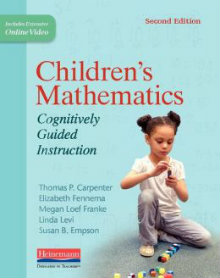Understanding How Kids Think about Math
Children’s Mathematics: Cognitively Guided Instruction 2nd Edition
By Thomas P. Carpenter, Elizabeth Fennema, Megan Loef Franke, Linda Levi, and Susan B. Empson
(Heinemann, 2015 – Learn more)
 Reviewed by Maia Fastabend
Reviewed by Maia Fastabend
Are you in search of a book that explains students’ mathematical thinking? Or often left wondering how your students came up with a wrong answer?
Children’s Mathematics: Cognitively Guided Instruction is a book that delves into answering common teacher questions about math learning.
A general synopsis of the K-5 book is that it provides ample grades 4/5 material detailing how students think and shows student work samples and online video clips of an instructor interacting with students to understand their thought processes. This is a book that should be on every undergraduate and graduate student’s list and one you will likely keep forever and not return to the buyback program or donate to your library book sale.
Video dialogues with students
 Children’s Mathematics begins by looking in depth at various addition and subtraction problems that can be classified by join, separate, part-part-whole (whole unknown and part unknown), and compare. After describing problem types, the authors offer examples with dialogue on what each of these problems looks like and how you can classify how students solve them.
Children’s Mathematics begins by looking in depth at various addition and subtraction problems that can be classified by join, separate, part-part-whole (whole unknown and part unknown), and compare. After describing problem types, the authors offer examples with dialogue on what each of these problems looks like and how you can classify how students solve them.
With each example is a short video clip about 3 minutes in length highlighting the dialogues of students explaining their thinking. The explanations are what teachers look for in understanding student work. The detailed movie interviews with students are conducted by experts in the field as it is obvious they know what questions to ask students to probe their thinking and find their understanding level without prompting them to an answer.
The videos also show the instructors going back to get students to describe their actions with manipulatives. This not only tells the instructor the student’s level of understanding, but also strengthens the student’s learning.
If a student is unsure or unable to recall exactly what they did, the instructor goes back and describes what they saw then asks the student why they chose to do that. The instructor’s clues to what they saw are usually enough to spark the student into a conversation about what they were doing and why. (On a side note, these are videos that all new teachers should watch prior to teaching each related standard.)
After an in-depth look at addition and subtraction, with a strong focus on whole numbers – an area the authors firmly believe holds the key to many students’ struggles with fractions and decimals during later years in mathematics – the book branches into multiplication and division, and briefly touches on the base ten system.
Much like the addition and subtraction section, the authors focus on classifying problems by the way students solve them and then explain what this means in terms of a student’s level of understanding. The videos are of high quality and continue to show students’ understandings.
The principles of cognitively guided instruction
The last section of the book focuses on principles of a classroom that uses the principles of cognitively guided instruction. While the student interview videos are a huge resource, the written content is very valuable as well. The chapters on CGI focus more on what a teacher could do instead of what problems looked like. This includes discussion and videos on investigating problems, eliciting discussion, discussing wrong answers, extending ideas, and engaging other students.
Overall I strongly recommend Children’s Mathematics for any math teacher who works with children from preschool – 8th grade or for those who work with struggling learners in grades 9-12. It is a book that should be on a bookcase for reference when looking over student work or after discussing problems with students.
The book provides thorough insights into basic number strategies that are the building blocks for fundamental mathematics and beyond. Other related books extend the CGI concept to fractions and decimals, and the integration of arithmetic and algebra.
Maia Fastabend is a 5th year teacher from Southern Oregon who when not teaching can be found whitewater kayaking or trail running. She has experience teaching 6th-8th grade general math and advanced math, and recently has found her niche teaching remedial/support. Musings about her teaching and current topics can be found at http://teachrunlife.blogspot.com/.

































